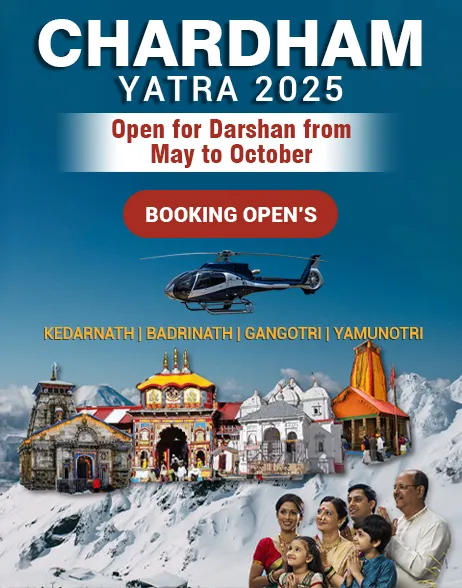Badrinath Dham which is also referred to as Badri Vishal has to be one of the most highly revered Lord Vishnu Divya Desam in the country. The colourful structure of the temple is so vibrant that it can be spotted easily from far away. When the temple is closed the idol of the holy deity is transferred among great joy and enthusiasm in a Doli to the nearby village of Joshimath where it resides in the Vasudeva temple for the pilgrims to complete their holy winter Char Dham Yatra. The temple is surrounded by the magnificent backdrop of the majestic snow bound Nar and Narayan twin peaks and this is probably the one Dham temple which can be reached without any hassle.
About the Temple :
The temple is a vibrant structure and is adorned with colourful works of simple art which only adds on to the beauty. It is built in the typical style of Indian temples consisting of a Mandapa and a Garbhagriha (the inner sanctorum where the idol is placed). Some people say that the temple initially was a Buddhist monastery and due to the wave of Hinduism brought in by Adi Shankara the monks and Buddhists who resided in the region were driven out and a temple was re-established. Ever since then the temple has seen innumerable pilgrims on their way for char Dham looking for their moksha or salvation.
Location : 11.7 km from Hanuman Chatti Dedicated to : Lord Vishnu
Altitude : 3,300 metres above sea level Built in : 7th century CE
Opened on : 24 April 2026 (Tentative) Closing on : Comming Soon
History of the Temple :
Being one of the holiest and highest Divya Desam out of the 108 scattered across the subcontinent Badrinath is dedicated to lord Badri or the king of Badri who is a form of lord Vishnu. Adi Shankara is credited with the revival of this Hindu temple when he had placed the idol of the lord that he had found on the Shore of Alaknanda River in a cave close to Tapt Kund in 7th century where it was initially worshipped. Later on in the 16th century the king of Garhwal discovered this holy site and kept it in a more secure place and got a temple made on top of it as an ode to the lord.
There are numerous legends surrounding the holy nature of this temple. One of them involves a story about how lord Vishnu, on being criticised by the sages, had performed deep meditation and penance here. On seeing the dedication his consort Goddess Laxmi is said to have protected him in the form of Badri Ka Vriksha (Badri tree) from the inhospitable and harshly changing weather conditions around them. Another legend suggests that Vishnu had once tricked lord Shiva in the form of a small crying baby in order to get that place for himself. No matter what the reason is the place is a pious destination which is worshipped by millions which is evident by the presence of a positive spiritual aura here.
How to Reach :
By Flight – The closest airport for Badrinath is situated at a distance of 310 km and it is the Jolly Grant airport in Dehradun. It caters to a number of flights from different parts of the country. On reaching you may book a cab or a taxi service and head on to your Badrinath yatra. The rates may vary from one operator to the other.
By Train – The nearest railway station is located in Rishikesh (the gateway to the Garhwals and the char Dham) at a distance of 292 km from the main Dham shrine. The station is well connected to a number of different states and cities of India and is one of the most cost-effective ways of travelling if you are coming in from a distance. Once you get off at the station you will be able to either book a taxi service, shared jeep or a bus service for heading to Badrinath temple directly.
By Road – If you have a private car and are used to driving on the hilly terrain then this is the best way to go. The roads are in very good condition and promises you a safe travel. Being one of the most well connected Dham sites the roads lead straight up to the entrance of the temple. The buses can be availed from the ISBT in Kashmiri gate or Anand Vihar New Delhi. You can even get the buses or shared cabs and jeeps at Haridwar or Rishikesh and there is no dearth of vehicles travelling for Badrinath.
Weather and Climate Information :
Winter (October to April) – Winter in Badrinath witnesses a serious drop in the temperature to as low as below 0. The temple activities are shut down and so do the temple gates. Darshan is halted for the season.
Summer (May to June) – This is the most peak time and the best time for you to travel to Badrinath. The days are comfortable and pleasant but do carry some woollen clothing for night. The pilgrim footfall is at its highest during this time.
Monsoon (July to Mid - September) - The entire region remains prone to heavy showers and rainfall. The Alaknanda River flowing by the temples becomes full and ferocious. Travelling is difficult but possible if you happen to make the trip on one of the sunny days. The temperature during this time also experiences a fall.
Best Time to Visit - If you are travelling with a group of family and friends then the summer months ensures that you have a comfortable and a tension free travel in a safe and secure manner. The temperature also during May to June are bearable and hospitable for travel as well as some nearby sightseeing.




